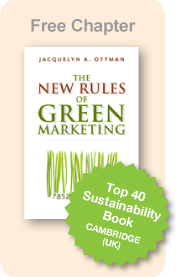Jacquie Ottman's
Green Marketing Blog
“Responsible Consumption” is the Next Frontier in Green Marketing
April 01, 2011 by Jacquelyn Ottman
Is Tom’s of Maine toothpaste really green if consumers leave the water running while they brush their teeth? Is an ENERGY STAR-rated light bulb really green if it remains on after everyone leaves the room?
 It is one thing to design a product to be greener, but the negative environmental impact made throughout a product’s life-cycle cannot be minimized unless the consumer uses and disposes of it responsibly. Representing the next frontier in green marketing, this is the
definition of responsible consumption (note: some might refer to it as
“shared responsibility.”
It is one thing to design a product to be greener, but the negative environmental impact made throughout a product’s life-cycle cannot be minimized unless the consumer uses and disposes of it responsibly. Representing the next frontier in green marketing, this is the
definition of responsible consumption (note: some might refer to it as
“shared responsibility.”
As I describe in my new book, The New Rules of Green Marketing: Strategies, Tools and Inspiration for Sustainable Branding (Berrett-Koehler, February 2011), sustainability leaders are striving for the ideal goals of zero waste and zero energy, but we will never get to zero —and thoroughly manage life cycle related environmental risks until people learn to responsibly consume and properly dispose of the products they buy.
The Consumer’s Role in Achieving Responsible Consumption
As life-cycle assessments for many products show, consumer usage can account for a significant portion of a product’s total environmental impact, especially products such as laundry detergents, soaps, and shampoos that require resources, energy, and water to work.
Manufacturers can design products to make it easier for consumers to minimize resource use, such as a duplex printing feature on a printer, or a dual-flush toilet. Real-time information, such as Toyota’s dashboard and the new crop of energy meters and monitoring services, also help. But only consumers can push the “cold” button on the washing machine or turn off the water when they brush.
Industry Incentives to Encourage Responsible Consumer Behavior
Businesses have myriad incentives to encourage such behavior, and some already are pioneering innovative ways to enlist consumer support. One big incentive is regulatory threat. When markets fail to address environmental ills, governments tend to intervene. Witness mandated shifts to energy-, fuel-, and water-efficient appliances, light bulbs, and cars. Will cold-water, laundry detergents, organic cotton, and leather-free shoes be next?
Another issue that industry needs to be mindful of is “the rebound effect”, whereby consumers will buy or use more of a product if it costs less due to enhanced efficiency. A classic example is fuel-efficient cars that are driven more miles than less-efficient cars.
Enlisting consumer support for responsible consumption can also help build credibility. Consumers intuitively understand that it is not possible to spend our way out of the environmental crisis. At the micro level, simply switching one supermarket-cartful of “brown” products with “green” ones will not cure environmental ills. Creating a sustainable society requires, among other things, that each of us use only what we need and that we help recapture resources for successive use by recycling and composting.
Lessons Learned From Sustainability Leaders
A key to the credibility of HSBC’s award-winning “No Small Change” green marketing campaign (which we at J. Ottman Consulting helped to guide along with JWT), was empowering retail customers and businesses to reduce their carbon footprint in line with the bank’s own efforts. In other words, we weren’t asking HSBC’s customers to do anything the bank hadn’t done itself.
Sustainability leaders are now winning their stakeholders’ respect by communicating the need to consume responsibly, especially in energy use. For starters, HP earned the No. 1 spot on Newsweek’s list of the top green companies of 2009 by pledging to reduce product emissions and energy usage 40% from 2005 levels by 2011. Realizing that it needs to partner with consumers to reach that goal, the company has launched its “Power to Change” campaign, which encourages users to turn off their computers when they do not need them (e.g., at night) and tracks actions to calculate energy and carbon impact.
Another example is Levi Strauss & Co., which teamed up with Goodwill to educate consumers on how to lower the life-cycle impacts of blue jeans. The company’s “A Care Tag For The Planet” campaign uses online and in-store messaging, and a new care tag on jeans, to encourage owners to wash in cold water, line dry when possible, and donate their jeans (when they’re no longer wanted) to Goodwill thrift stores. The company estimates that such steps by responsible consumers can reduce life-cycle climate-change impacts in half.
Similarly, in Europe, Procter & Gamble’s Ariel runs a “Turn to 30” (degrees centigrade) campaign to encourage consumers to wash at lower temperatures. Spurred by the threat of regulation, the laundry detergent industry has united to promote responsible washing. And an industrywide Washright campaign launched in 1998 by the Brussels-based International Association for Soaps, Detergents and Maintenance Products (AISE) reached 70% of European households with tips on how to wash laundry in environmentally preferable ways.
A final example is the Sacramento Municipal Utility District, which has learned that peer pressure is an excellent strategy for promoting responsible consumption—and may be even more motivating than saving money. In a test that began in April 2008, some 35,000 randomly selected customers were told via “happy” or “sad” faces (printed on their monthly utility bills) how their energy use compared with that of their neighbors and the most-efficient energy users in the district. Customers who received the information cut their electricity use 2%, compared with no change by counterparts who did not receive messages. The utility expanded the program to 50,000 households in August 2009.
(Originally published on Marketingprofs.com on March 30, 2011)
This is an important issue for me, and one that I’m spearheading with clients. If you have an example to share or a comment to discuss, please contact me directly at info (at) greenmarketing.com
Jacquelyn Ottman is an expert adviser on green marketing to Fortune 500 companies and the U.S. government. The author of four books on the subject, her latest is the just released, The New Rules of Green Marketing: Strategies, Tools, and Inspiration for Sustainable Branding (Berrett-Koehler, February 2011), 252pp. $21.95. Her firm’s website, http://www.greenmarketing.com, contains more information about the book.



 ShareThis
ShareThis

